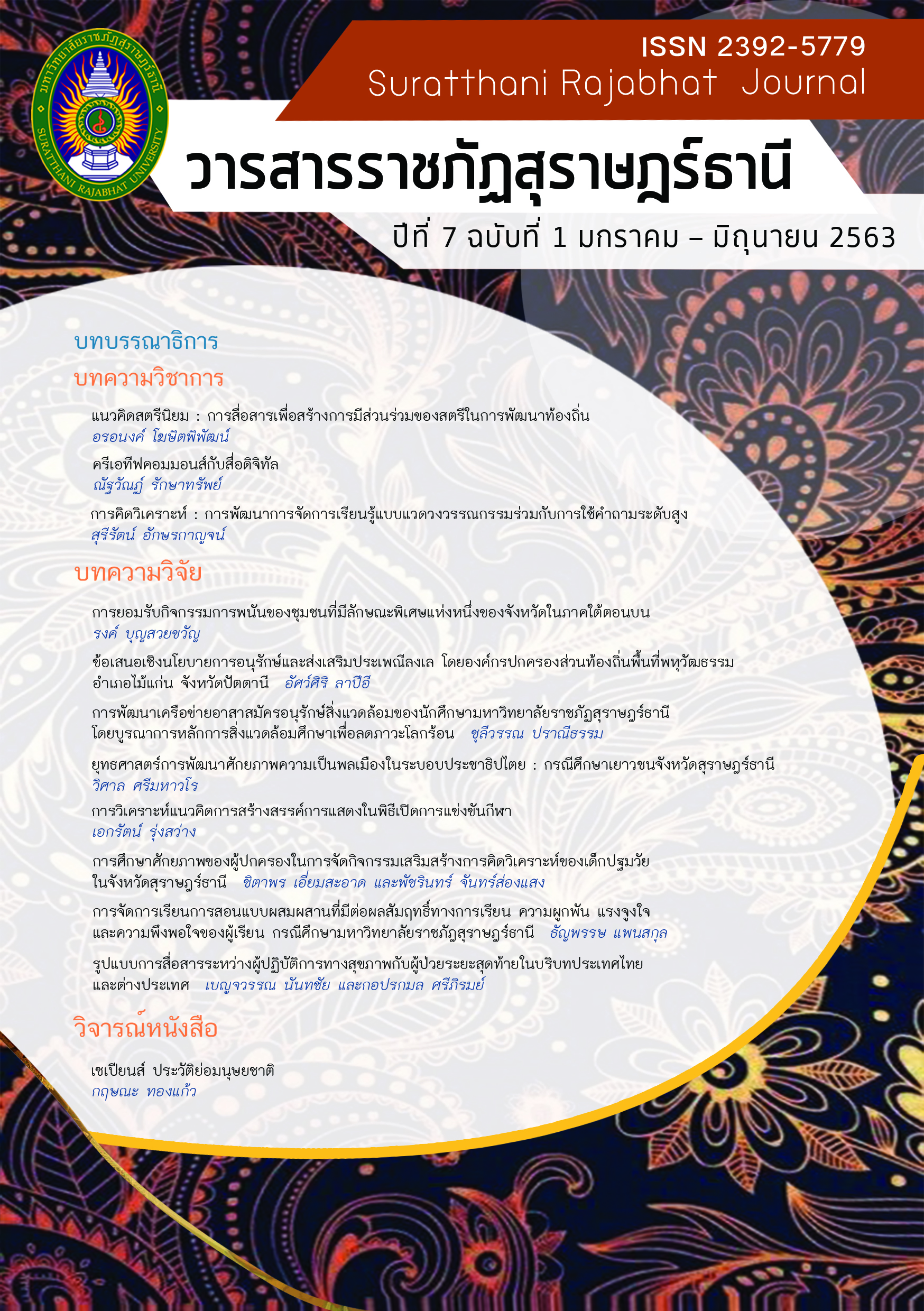Patterns of Communication between Health Care Practitioners and Terminally-ill Patients in the Context of Thailand and Foreign Countries
Main Article Content
Abstract
This study was a qualitative study that aimed to analyse and synthesise the patterns of speech acts in communication between health practitioners and terminally-ill patients who are confronting life-threatening terminal illnesses in Thailand and foreign countries. The researcher studied a data collection from international databases at Science Direct since 2007-2015 with the number of 10 documents in Thailand and 10 academic documents in foreign countries. A conceptual framework in this research was theory, human caring, and human hierarchy of needs. A qualitative study by content analysis of a group of utterances/statements was used in communicative interactions between health care practitioners and terminally-ill patients, specific in locutionary acts and illocutionary acts. Data were analyzed using identified speech acts in five categories: notice group, suggestive group, showing feelings group, bonded group, and bulletin group. Data were analyzed by using percentage statistics and content analysis. The results showed that health practitioners in Thailand used verbal interpretations more directly than foreign health workers at 64.90%. The final stage of patients in foreign countries used the verbal act to perform the most feelings at 60.01%. The notice groups and suggestive groups were similar in both Thailand and foreign countries. The least common speech act groups were bonded group and bulletin groups.
Article Details
References
จิตชญา บุญนันท์ และปรางทิพย์ ฉายพุทธ. (2552). บทบาทพยาบาลในการสื่อสารเรื่องไม่พึงประสงค์หรือแจ้งข่าวร้ายในผู้ป่วยมะเร็ง. วารสารสภาการพยาบาล, 24 (3), 7-19.
ชิษณุ พันธุ์เจริญ. (2553).การสื่อสารสำหรับผู้ป่วยระยะสุดท้าย [ออนไลน์]. ค้นเมื่อ 25 ธันวาคม 2559 จาก http://www.chulacc.com/forum/index. php?topic =438.0.
ดาริน จตุรภัทรพร. (2554). สุข รัก เข้าใจในช่วงสุดท้ายของชีวิต (Palliative care). กรุงเทพฯ: อมรินทร์พริ้นติ้ง.
ทัศนา บุญทอง. (2554). ทฤษฎีพื้นฐานทางการพยาบาลจิตเวช. เอกสารการสอนชุดวิชากรณีเลือกสรรการพยาบาลมารดาทารกและการพยาบาลจิตเวช หน่วยที่ 1-7. นนทบุรี: โรงพิมพ์มหาวิทยาลัยสุโขทัยธรรมาธิราช.
บังอร ไทรเกตุ. (บรรณาธิการ). (2556). การดูแลผู้ป่วยระยะสุดท้ายแบบประคับประคอง. กรุงเทพฯ: สำนักงานคณะกรรมการสุขภาพแห่งชาติ.
วราภรณ์ คงสุวรรณและ คณะ. (2557). อุปสรรคในการดูแลผู้ป่วยวิกฤตใกล้ตายที่ห้องฉุกเฉิน: ประสบการณ์ของพยาบาล. วารสารพยาบาลสงขลานครินทร์, 34 (3), 97-108.
สันต์ หัตถีรัตน์. (2551). การดูแลผู้ป่วยให้ “ตายดี” (10) ภาคผนวก : สุดยอดแห่งชีวิต [ออนไลน์]. ค้นเมื่อ 22 ธันวาคม 2559 จาก https://www.doctor.or. th/clinic/detail/9343.
สำนักงานคณะกรรมการสุขภาพแห่งชาติ. (2552). ธรรมนูญว่าด้วยระบบสุขภาพแห่งชาติ พ.ศ.2552 . นนทบุรี: วิกิ.
สุพัตรา ศรีวณิชชากร. (2553). การดูแลและเยียวยาด้วยหัวใจและศรัทธา. วารสารบริการปฐมภูมิและเวชศาสตร์ครอบครัว, 2(5), 4-6.
แสวง บุญเฉลิมวิภาส. (2553). กฎกระทรวงกำหนดหลักเกณฑ์และวิธีเนินการตามหนังสือแสดงเจตนาไม่ประสงค์จะรับบริการสาธารณสุขที่เป็นไปเพียงเพื่อยืดการตายในวาระสุดท้ายของชีวิต หรือเพื่อยุติการทรมานจากการ เจ็บป่วย. กรุงเทพฯ: ศูนย์กฎหมายสุขภาพและจริยศาสตร์ คณะนิติศาสตร์ มหาวิทยาลัยธรรมศาสตร์.
อรพรรณ ลือบุญธวัชชัย. (2545). การพยาบาลสุขภาพจิตและจิตเวช. กรุงเทพฯ : ด่านสุทธาอัมรินทร์บุ๊คเซ็นเตอร์ จำกัด.
Almack, Cox, Moghaddam, Pollock and Seymour. (2012). after you: conversations between patients and healthcare professionals in planning for end of life care [Online]. Retrieved on 14 November, from: http://www.biomedcentral.com/1472-684X/11 /15.
Austin, J. L. (1962). How to do things with words [Online]. Retrieved on 20 September 2016, from: http://www.hup.harvard.edu/catalog. php?isbn=97806748527 16.
Balzer- Riley. (2012). Communication in Nursing. St. Louis. Mosby.
Bélanger, Rodríguez, Groleau, Légaré4, Macdonald and Marchand. (2014). initiating decision-making conversations in palliative care: an ethnographic discourse analysis [Online]. Retrieved on 14 November 2016, from: http://bmcpalliatcare.biomedcentral.com/ articles/10.1186/1472-684X-13-63.
Cherry, Kendra. (2016). 18 Common defense mechanisms used for anxiety [Online]. Retrieved on 23 December 2016, from: https:// www.verywell. com/de fense-mechanisms-2795960.
Johnston, S. (2006). Nurses’ and patients’ perceptions of expert palliative nursing care [Online]. Retrieved on 12 December 2016, from: http://online library.wiley.com/doi/10.1111/j.1365-2648.2006. 03857.x/abstract.
Kübler, R. (1969). The 5 stages of grief and loss [Online]. Retrieved on 12 August 2016, from: http://psychcentral.com/lib/the-5-stages-of-loss-and-grief/.
Maslow, A. (1954). Maslow's hierarchical theory of motivation [Online]. Retrieved on 16 November 2016, From: http://www.edpsyc interactive. org/topics/ conation/maslow.html.
Searle, J. R., Vanderveken Daniel. (1969). Introduction to the theory of speech acts of John Searle & foundations of illocutionary logic [Online]. Cambridge University Press. Retrieved on 20 September 2016, from: http://www.u qtr.uquebec.ca/~vandervk/05_Searle_ vanderveken. pdf.
Skulason, Hauksdottir A., Ahcic K. and Helgason AR. (March11, 2014). Death talk: gender differences in talking about one's own impending death [Online]. Retrieved on 11 October 2016, from: https:// bmcpalliatcare.biomedcentral.com/articles/10.../1472-684X-13-8.
Watson, J. (2008). Nursing: The philosophy and science of caring [Online]. Retrieved on 11 November 2016, from: https://www. watsoncaringscience.org/files/Cohort%206/watsons-theory-of-hu man-caring-core-concepts-and-evolution-to-caritas-processes-handout.pdf.
World Health Organization. (2014). WHO’s Definition of palliative care [Online]. Retrieved on 11 November 2016, from: http://www.who. int/cancer/palliative/en/.


